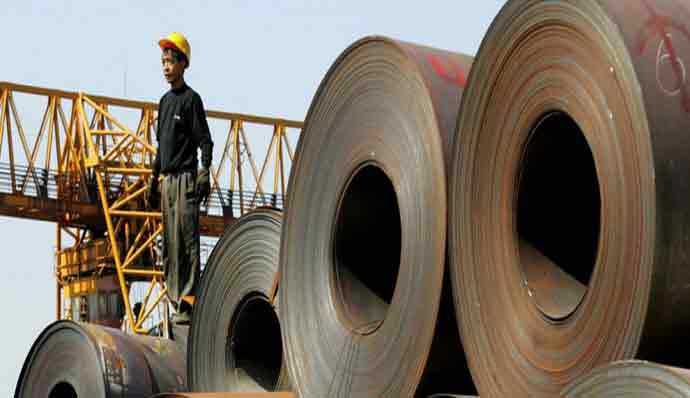By Aya Khodair
Two of China’s largest steel companies have announced plans to merge for creating the world’s second largest steelmaker, as the industry struggles with global overproduction. Under the deal, Baosteel is to take over its smaller competitor Wuhan Iron and Steel. Both companies are majority-owned by the state. The announcement comes as Beijing tries to overhaul the steel industry, one of the country’s bloated state sectors.
The merger will create a new company, China Baowu Iron and Steel Group. Based on data from 2015, the two firms together have an annual production of about 60 million tons a year, which would make it the country’s largest steelmaker.
Globally, it would be second only to Luxembourg-based ArcelorMittal. According to the BBC, Baosteel’s net profit tumbled 83% to 1billion yuan ($150 million) last year, while Wuhan lost 7.5 billion yuan, a sharp drop from its 1.3 billion yuan net profit in 2014.
Steel demand in China, as well as worldwide, has slumped in the past year as the country’s economic growth has slowed. The resulting overproduction has seen steelmakers around the world suffer huge losses. China has been accused of price dumping – selling its steel cheaply overseas in order to clear its stocks.
In April, China promised to reduce its steel output, following a crisis meeting attended by 30 nations. Over the past 25 years, Chinese steel production has expanded hugely with output growing more than twelve-fold.
China produced more than 822 million tons of steel in 2014 and is expected to produce even more this year. However, projected demand for its steel in 2016 is only 672 million tons.
According to china South Morning Post, China’s government is nudging the country’s state-owned industries and factories to consolidate and restructure — part of president Xi’s so-called supply-side reforms — to help them withstand the slowest economic growth pace in decades.
The consolidation has fallen behind schedule, as provincial governments have been reluctant to lose grip of vital industries, jobs creators, and tax contributors in their local areas.
China has set a target to cut excess capacity in steel by 45 million tons by the end of November. A mere 47 per cent of that target was reached as at the end of July, according to the latest available data from the National Development & Reform Commission.
Steel production actually rose by 2.2 per cent in the first eight months of 2016, compared with the same period last year.
China has the capacity to produce 1.2 billion tons of crude steel every year, a record level in 2015 that’s also become a source of friction with the US and European Union, leading to complaints of dumping by Chinese steel mills at the World Trade Organisation.
However, according to BBC analysts said that the deal between Baoshan Iron and Steel and Wuhan Iron and Steel is only part of what is likely to be a long and complex process to consolidate China’s fragmented steel industry.
According to financial Times, on Tuesday Baoshan, the listed arm of China’s second-largest steel producer Baosteel Group, said it would issue new shares in order to absorb the listed arm of Wuhan Iron and Steel Group, China’s fifth-largest steel producer by volume.
The subsuming of Wisco’s traded entity by Baosteel’s listed unit is a preliminary step in the merging of the two parent groups, and is subject to Chinese regulatory approval, according to a filing by both companies.
The merger does not mean success of this “test case”, according to Xu Zhongbo, analyst at Beijing Metals Consulting. “The most important thing is that steel production comes together quickly,” he said.
“In the two groups there many small companies and it will take a long time to decide which businesses will be sold or closed — this could be a costly process,” he said.
The creation of the Baowu Steel Group — as China’s press has dubbed the merged entity — is considered the starting point for Beijing’s plans to improve Chinese efficiency by pushing zombie companies out of operation.
China’s steel’s overcapacity helped plunge the global industry into crisis last year, when surging cheap Chinese exports dragged down global prices.
The looming plan to merge the entirety of Wisco and Baosteel Groups into a single entity — with assets of Rmb700 billion ($104.9 billion) and 60 million tons of annual capacity — has already been approved by the State-owned Assets Supervision and Administration Commission, according to respected financial magazine Caixin.
Consolidation may address oversupply but past experience points to caution. The finalisation of the deal is a poster child for a recently released plan from the State Council, China’s cabinet, to whittle Chinese steel companies down to a handful of groups responsible for the majority of production by 2025. Small private companies currently account for half the country’s output.
However, such plans have previously been touted — in 2005, Beijing said it hoped its top 10 steel producers would account for 70 per cent of production by 2020.
A flurry of hook-ups from the past government push failed to materialise as companies each fought to individually reap the benefits of a stimulus-aided construction boom and steel demand spike in the late 2000s.
Beijing is hoping that tough market conditions will allow them to push through mergers with greater speed.
On Tuesday, two smaller state-owned steel companies, Angang Steel and Bengang Steel Plates, halted trading and the Chinese press reported that a potential merge of the two listed companies was on the cards. A merger between the two companies’ parent groups was originally announced in 2005.


